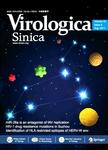Labeling of influenza viruses with synthetic fluorescent and biotin-labeled lipids
Labeling of influenza viruses with synthetic fluorescent and biotin-labeled lipids作者机构:Food and Drug Administration 29 Lincoln DriveBethesda 20892 MD USA Shemyakin Institute of Bioorganic Chemistry Russian Academy of Sciences Miklukho Maklaya 16/10Moscow 117997 Russia Chumakov Institute of Poliomyelitis and Viral Encephalitides Russian Academy of Medical SciencesMoscow Region 142782 Russia Biotechnology Research Institute AUT University Private Bag 92006Auckland 1142 New Zealand
出 版 物:《Virologica Sinica》 (中国病毒学(英文版))
年 卷 期:2014年第29卷第4期
页 面:199-210页
核心收录:
学科分类:1007[医学-药学(可授医学、理学学位)] 100705[医学-微生物与生化药学] 1001[医学-基础医学(可授医学、理学学位)] 100103[医学-病原生物学] 10[医学]
基 金:partially(NVB) supported by RAS Presidium Grant "Molecular and Cell Biology"
主 题:bioimaging Function-Spacer-Lipid (FSL) constructs labeling of influenza viruses synthetic lipids
摘 要:Direct labeling of virus particles is a powerful tool for the visualization of virus–cell interaction events. However, this technique involves the chemical modification of viral proteins that affects viral biological properties. Here we describe an alternative approach of influenza virus labeling that utilizes Function-Spacer-Lipid(FSL) constructs that can be gently inserted into the virus membrane. We assessed whether labeling with fluorescent(fluo-Ad-DOPE) or biotin-labeled(biot-CMG2-DOPE) probes has any deleterious effect on influenza virus hemagglutinin(HA) receptor specificity, neuraminidase(NA) activity, or replicative ability in vitro. Our data clearly show that neither construct significantly affected influenza virus infectivity or viral affinity to sialyl receptors. Neither construct influenced the NA activities of the influenza viruses tested, except the A/Puerto Rico/8/34(H1N1) strain. Our data indicate that lipid labeling provides a powerful tool to analyze influenza virus infection in vitro.



